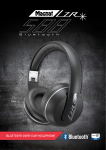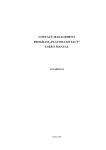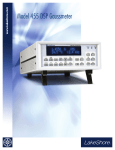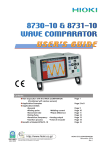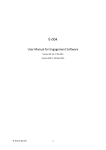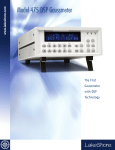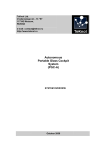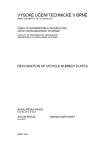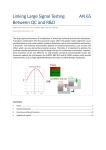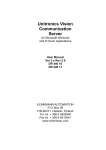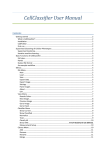Download S21 - Ambient Noise immunity
Transcript
Production Noise Immunity S21 FEATURES BENEFITS • Auto-detection of noise disturbance • Full ambient noise immunity • Extension of Standard SPL task • No need to change sequences or settings • Applicable to Rub&Buzz, Harmonics and Fundamental • Fundamental monitoring for headphones and telecom (low level) products • User definable number of repetitions • Minimize testing time using merging • Simple repeat function and intelligent merging technology • Simple set-up (3 parameters) • Considers noise attenuation of test enclosure Defects such as rub and buzz, loose particles, air leakage, and other mechanical problems causes symptoms, which are 80 dB below the fundamental but still audible and not acceptable in the final application. Even moderate production noise during end-of-line testing (QC) can easily corrupt the measurement and cause wrong PASS/FAIL results. The Noise Immunity option of the Klippel QC system copes with this problem providing full noise immunity. Based on a new method the impact of ambient noise is reliably predicted using a second microphone. Corrupted measurements are repeated automatically and moreover the valid parts may be merged together giving the accurate result eventually in a minimal time. Application: - End-of-line testing - Coping with production noise - Testing of large audio components that cannot be tested in enclosures Article Number: Sequence of repeated test #4000-250 CONTENTS: Background / Theory ............................................................................................................................... 2 General Features..................................................................................................................................... 3 Hardware Setup....................................................................................................................................... 3 Setup ....................................................................................................................................................... 4 Limits ....................................................................................................................................................... 5 Limitations................................................................................................................................................ 6 Applications ............................................................................................................................................. 6 Updated August 26, 2010 Klippel GmbH Mendelssohnallee 30 01309 Dresden, Germany www.klippel.de [email protected] TEL: +49-351-251 35 35 FAX: +49-351-251 34 31[r1] S21 Noise Immunity Option Background / Theory Limits valid measurement Noise microphone ambient noise Merging DUT Test Microphone Classificator Fail Pass Corrupted measurement Noise Detection Generator auto-repeat The test microphone is typically located in a (optional) test enclosure near to the sound source. Using a noise microphone production noise is measured in the far field (outside a test box). A noise detection algorithm is used to predict the impact of ambient noise at the test microphone position. If the predicted noise exceeds an automatically calculated limit, the measurement is considered as corrupted and needs to be repeated. The following measures are susceptible to ambient noise and are supervised by the Noise Immunity Options: • • • • • Frequency Response Level (average level) Polarity nd th THD, 2 – 4 harmonic distortion Rub&Buzz Using the new Merging Technology, all valid parts of measurements are stored and accumulated until a complete valid result can be calculated. An active compensation of ambient noise is not possible due to the complex 3D nature of ambient noise. Definitions The following definitions are used in this specification: Susceptible measure: A measure (single value or curve) which may be corrupted by ambient noise (e.g. Rub&Buzz) Noise measure: For each susceptible measure (curve type only) an individual noise measure exists, that reflects the impact of ambient noise at the test microphone position Test Microphone: Usually located in the near field to measure the response and other characteristics of the test object Noise microphone: A second microphone recording the noise signal outside a test box in about 1m distance. Also other sensors may be used such as acceleration sensors. KLIPPEL QC SYSTEM page 2 S21 Noise Immunity Option General Features Licence Activation Data compatibility The Noise Immunity (NI) option requires a separate license. It is not part of the Standard QC package. The Noise Immunity (NI) option can be activated by enabling the NOISE measure on the property page tasks. Note that the NI extended functions are not available as long as reference measurements measured by older scripts versions exist. See also chapter Data compatibility below. The Noise Immunity (NI) option is an add-on to the standard SPL-task. If upgraded to the NI option by installing the NI licence, all old data (limits, reference DUTs) are kept and can be used as before. If reference DUTs measured with older version of the SPL task are still used in a test, the NI option cannot be activated. To use the NI functionality, new reference DUTs must be measured. The system automatically detects this condition and provides the additional user interface on the property page TASKS and LIMITS as described below. Hardware Setup Setup Test Enclosure Ambient Noise (1 m Distance) Test Microphone DUT PU SH PU SH Production Analyzer I ICP1 FireWire • • • Microphones Microphone Sensitivity Power USB Digital I/0 Amplifier Speaker 1 Speaker 2 OUT1 OUT2 ICP2 MIC1 LINE1 LINE2 PWR 0 MIC2 Test enclosure is optional Ambient noise microphone must be connected to MIC2 Test Microphone can be connected to MIC1 (ICP) or LINE1 (using external microphone power supply) All ICP powered microphones may be used with the QC Test System. For measurements in a closed box a low sensitivity microphone is required since sound pressure level exceeds 130 dB easily. Also other ICP power sensors such as acceleration sensors may be used. For optimal performance under free field conditions the ambient noise microphone should have at least 6dB lower noise floor than the near field microphone. For near-field testing a high SPL mic (low sensitivity, e.g. MI17-HL) should be used while for noise monitoring a standard SPL microphone (e.g. MI17) is recommended. If a test enclosure can be used this limitation is not as critical depending on the actual noise damping. Calibration All used microphones must be calibrated carefully using a calibrator (e.g. pistonphone) or using the specification sheet data. KLIPPEL QC SYSTEM page 3 S21 Noise Immunity Option Acoustical Environment To optimize the attenuation of the test enclosure, consider the following points: • Avoid parallel walls (reduces standing waves inside the cavity). • Allow sufficient volume to reduce mechanical vibrations. • Check the highest SPL level inside the box. At the very end of the QC User Manual helpful rules to estimate the max SPL are given. • Use appropriate high SPL microphones (available up to 155 dB). • Consider providing an anechoic trap for low frequencies, if testing woofers. This could be a larger volume filled with absorptive material being part of the overall test enclosure. • Provide damping material at inner walls of the box to attenuate high frequencies. • Avoid any mechanical gear inside the box. Mount all equipment for closing the test box at the outside to avoid any parasitic resonance inside the box. • Consider an isolation from the ground to decouple structure-borne noise • Avoid any machines, generators, magnetizers, and fans close to the test box. Setup Number of repetitions Mode of repetition Microphone Position A maximal number of repetitions are to be specified. If all repeated tests are disturbed by ambient noise, a NOISE warning is shown. Please check in this case, if a continuous noise source is corrupting the test at one frequency. Two modes of repetitions are provided: • All: A disturbed test will be repeated until a complete undisturbed test by ambient noise is done or the maximal number of repetitions is reached. In this mode the whole response is taken from the last repetition, no merging is applied. • Corrupted only: In case noise corruption is detected for certain frequencies, these frequencies will be dismissed and only valid parts of the response are stored. During repetition all missing frequencies are merged and accumulated if uncorrupted until the whole frequency range is valid. If the response violates a limit at uncorrupted frequenciesthe test is aborted and the measure is marked accordingly as FAIL. All measures, which are not tested completely at this moment (since they are still corrupted by noise), are marked as VOID. The selection of the microphone position is part of the standard SPL task (without NI option). However, it is described here in detail since it is relevant for noise immunity as well. Independent of the mode selected, the ambient noise microphone should be placed in direction of the most likely disturbance. Allow about 1 m distance from the test box or the test microphone (in case of free field conditions). The following options are available: • Free Air: no test enclosure is used. This setting can be used for evaluation and for particular setups, where no test enclosure can be applied. It is not recommended for testing driver and smaller systems. • Test Box: an average attenuation of 15dB over the full bandwidth is assumed, when activating this mode. This setup should be used, if the attenuation of the test box is not known. This attenuation is typical for simple wooden test enclosures with an opening for drivers to be tested. MIC 2 (Ambient Noise) ≈ 1m MIC 1 / Line (near-field) Test Box (Enclosure) • KLIPPEL QC SYSTEM Custom: It is recommended to measure the noise as a transfer function of inside and outside noise. A frequency dependent curve can be specified which will be used to predict the impact of the ambient noise at the measurement microphone position. page 4 S21 Noise Immunity Option Shielding If the microphone position is set to custom, the box attenuation curve is to be specified by the user. For instructions on the measurement of the noise attenuation, please see the manual of the Noise Immunity Option. Note that the test object cannot be used as sound source in the normal test position. An external noise with high SPL output shall be used. Box Attenuation Inside Box Outside Box KLIPPEL 110 105 100 95 90 85 80 75 70 102 103 104 Typical attenuation of a simple test enclosure (red curve: inside box, blue curve: outside) Show Noise Curves The predicted noise curves for • Frequency Response nd th • THD, 2 – 4 harmonic distortion • Rub&Buzz can be displayed when activating the Show Noise Curves option in section DISPLAY on property page Tasks. Noise curves are always displayed in the same charts as the according measure curves. The colour of the noise curves is automatically derived from the measure curve colour. For normal use, this option should be switched off for a better overview of the results. It can be activated after a measurement to display the predicted noise curves of the latest measurement for diagnostics. Limits Automatic Prediction Limit Calculation Based on the specified noise attenuation the impact of the ambient noise is predicted at the position of the measurement microphone. No more parameters are needed for this prediction based on the measured ambient noise signal. Each measure has its own noise measure. The method of limit calculation for the noise measure is the same as defined for the actual susceptible measure. No separate parameters are needed. There is one exception: For Rub&Buzz the user may specify the mode of calculation for the noise limit. The default method is “derived from Rub&Buzz”, which means automatic calculation as described before. For special applications (e.g. acceleration sensors instead of noise microphone) this mode can be used to determine noise corruption. KLIPPEL QC SYSTEM page 5 S21 Noise Immunity Option Limitations Warning ”Sensitivity Lost” Noise inside test enclosure Noise free area The noise immunity option guarantees uncorrupted measurements. To ensure this feature, the predicted noise of a good (not disturbed) test of the reference units must be lower than the measure to be supervised for all frequencies. Especially if the noise attenuation is low (free air condition, bad damping of test box), this is not always the case. To ensure noise immune testing, the limit of the susceptible measure is relaxed and the sensitivity of the test is therefore decreased. If the system detects this case, a warning is issued when calculating limits in the Summary chart. In this case, it is recommended to • Use a test box if possible or to • Use a more sensitive microphone for the ambient noise. The level of the ambient noise is usually much lower and hence more sensitive microphones with lower noise floor can be used. • Relax the limits of the susceptible measure to have this loss under control. Avoid any parasitic vibration and rattling inside the test box. This noise is not monitored and cannot be detected by outside microphones. Carefully check the resonances inside the box before using it with the test object. You may use the Manual Sweep and increase the test voltage by about 3 dB or more to get some headroom for vibration diagnostics. This test highly depends on the test object type and should be done for each type. A check on a regular basis is also recommended. A minimal distance around the test box should be kept free from any noise source. The ambient noise microphone should be placed in direction of the most likely disturbance. Allow about 1 m distance between test box and ambient noise microphone. Applications Driver Testing For driver testing under normal test conditions (using test box, driver is firing into box), the NI option ensures that Rub&Buzz problems or other low level driver defects can reliably separated from ambient noise disturbances. In conventional test systems a defect cannot be separated from such defects. Exploiting the extremely short measurement time of Klippel QC, repetitions do not degrade the overall measurement time too much. Consequently, a higher yield of production is obtained using NI option. KLIPPEL QC SYSTEM MIC 1 / Line (Nearfield) Test Box (Enclosure) Driver test setup page 6 S21 Noise Immunity Option System Testing Closed box system test Depending on the physical size of the systems to be tested a test box cannot be applied without spending high cost, long time for changing test objects and handling problems. For smaller systems see section above. If the system is to be measured in more or less free air conditions (no or insufficient noise attenuation possible), the NI option is crucial for reliable testing. In most cases the test sequence is rather longer than for drivers (more channels, multiplexer usage…) and a complete repetition is not efficient in case a single test step failed due to ambient noise. The NI option only repeats the corrupted tests and ensures an overall noise corruption free measurement. Using semi-open test boxes the handling can be simplified considerably and noise corruption can be excluded by the NI option. As depicted in the example a production line can be partly shielded against ambient noise for testing. Thus cost and handling time can be reduced significantly. Semi-open box system test on production belt updated August 26, 2010 Klippel GmbH Mendelssohnallee 30 01309 Dresden, Germany KLIPPEL QC SYSTEM www.klippel.de [email protected] TEL: +49-351-251 35 35 FAX: +49-351-251 34 31 page 7








